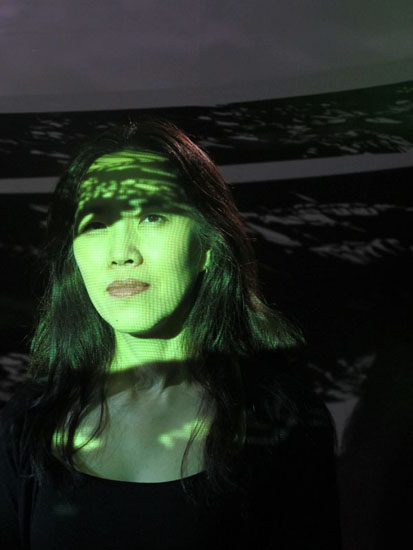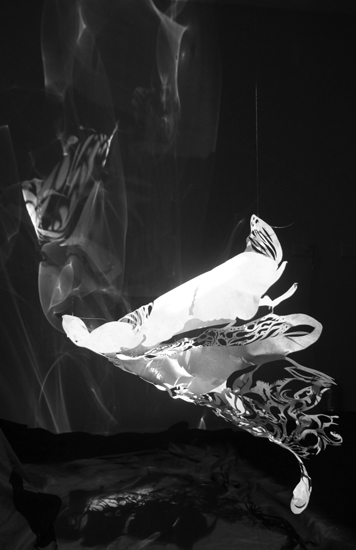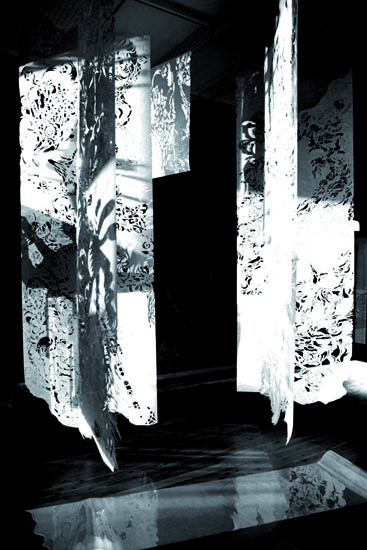Luise Guest spoke with Sydney-based, Chinese-born artist Tianli Zu on the eve of the exhibition ‘In Possible Worlds’ at 4A Centre for Contemporary Asian Art…
Tianli Zu, White Shadows (installation view), 2012-13. Acetate film, painted with acrylic, hand cut and installation with multiple animation projections. Dimensions variable. Image courtesy the artist
It was the Chinese who invented paper more than two thousand years ago. Ever since that time, intricate paper cuts have been believed to bring good fortune when hung outside doorways and on windows. In the distant past they were created mainly by women, who learned to cut complex designs of pomegranates, peach blossom and lotus flower, as well as the symbolic animals of the Chinese lunar calendar. Skilful paper cutting was one of the skills expected of a bride. Today, it is one of the traditional folk art forms that contemporary Chinese artists are reinventing and transforming in surprising ways, often combined with new media and digital technologies. In Beijing, painter and animation artist Wu Junyong wields his scissors with speed and dexterity to cut all sorts of magical creatures derived from both eastern and western folk tales, as well as his trademark male figures wearing tall pointed ‘scholar’ hats. They are the starting point for dark satirical animations, which take traditional folk tales and then give them a confronting political edge.
In Shanghai, Chen Hangfeng uses paper cutting too, but instead of the traditional flowers, animals, fat babies and double happiness symbols his intricate works hide the corporate logos of the global brands which have transformed the face of China. It takes a moment to realise that what you are seeing in his ‘Logomania’ series are the identifying symbols of brands such as Mcdonalds, KFC, Nike and Adidas. It’s a salutary reminder that branding is so seamlessly enmeshed into the fabric of our lives that we no longer really notice it. Here in Sydney, Tianli Zu uses the skills she learned growing up in China to create complex paper cuts which form the basis of her immersive site-specific multi-media installations. Like Wu Junyong and Chen Hangfeng, she uses a traditional form to represent contemporary ideas.
I spoke with Zu about her practice, and in particular her new work, ‘White Shadows’ at 4 A Centre for Contemporary Asian Art. Long scrolls of intricately cut paper attached to clear acetate hang suspended horizontally from the ceiling. Reminiscent of Buddhist sutra scrolls, they suggest temple architecture. We sat on folding chairs in the darkened space, faces illuminated by her ethereal projections, our conversation occasionally interrupted by the sounds of sawing and hammering as the exhibition ‘In Possible Worlds’ was installed. Projected shadows, created from animated cut-out forms and lights directed through the delicate paper cuts played around us as we spoke.
Our conversation ranged across many topics, from Zu’s childhood during the Cultural Revolution, to her experiences of learning paper cutting from peasants in Shanxi Province, through to the challenges she faces today juggling the different roles required of contemporary women. She spoke of her interest in Taoism, and the philosophy of yin and yang – the tensions inherent in the binary opposites which make up our world. These are symbolised in her work by light and dark, projection and shadow. As we spoke about her early life she pointed out key images as they moved slowly across the walls of the space. I see squadrons of fighter planes and slowly falling bombs, in reference to a cousin who fought in Vietnam. A bamboo bird cage and the figure of an axe-wielding pigtailed woman come from dark folk tales. The work reminds us of all the most frightening aspects of childhood: the monsters lurking in the darkness; the fear of the unknown.
Zu sees the shadow as a metaphor for things which are repressed or hidden in the everyday world, especially aspects of femininity and female desire. She works directly, cutting the paper by hand without sketches or preparatory drawings. The act of cutting is performative and cathartic. Themes of opposing forces, hidden truths and dark shadows emerge throughout our conversation. Zu’s intellectual parents (her mother a celebrated documentary film-maker and her father an editor) had a vast library of books. At the front of the bookcase were the volumes of Maoist and Leninist theory, but hidden behind these was another layer, which included much Western literature including Shakespeare and Dante. “It was wonderful!” she said. “I would just read – I got the chance because school was not too hard for me, I was the best student. I lived up to my parents’ expectation.” She had considerable freedom in this period of her childhood. She remembers climbing trees, having adventures, even getting in a few fights. “I had a slingshot, I was just like a boy! They cut my hair short, I wore boys’ clothes.” Binaries of masculinity and femininity, sex and death, eros and thanatos, play out in all her imagery.
When she was in her final years of high school Tianli Zu sometimes visited her mother’s workplace at the film studio after class. She learned how to edit film, yet she also saw how editing was used to present a particular, acceptable version of the truth. Similarly, observing her father’s work as an editor of history and reference books, she witnessed first-hand the ways in which truth was manipulated for political ends. “The lie is always there,” she says. In response, she positions herself in a dialogue of duality. “My work is talking about yin, or weakness, or darkness,” she says. “What is the power of the shadow?” I ask. For a moment there is silence as the artist thinks about her response. The cut-out form of a birdcage is silhouetted across her face. Finally she says, “The shadow is revealing the truth. The power is that it needs the light to be revealed. When the light shines through the cut, it casts the shadow and occupies the space. Then they are immortal and they live forever. The shadow becomes free but is hanging in your mind.” Later, she sent me a message to clarify her intentions: “I would like to think that although I am tangled in this material world as much as others, my art is about looking for a chance to transcend or go beyond.”
Tianli Zu photographed with her work ‘White Shadows’ at 4 A Centre for Contemporary Asian Art, photograph Luise Guest reproduced with permission of the artist and 4A.
Her childhood and teenage years were spent in Beijing, during the tumultuous 1960s and 1970s. Tianli Zu grew up with her grandparents. Her parents were ‘sent down’ to the countryside during the Cultural Revolution, but even before that time her childhood memories are filled with dark shadows. “The day I was born, my mother cried. I was born on the national day, which should have been a happy time. But she said to my father, ‘Another girl’, and then from the first day I came back from the hospital I lived with my grandparents.” She had a sense, always, of being unwanted. “They always said they intend to exchange me with my boy cousins,” she says sadly. “But I always wanted to be loved. This love thing is to me so important, and I wanted to be loved, and I always wanted to make them happy and satisfied. But each time … I am always in the wrong.” When her parents made their infrequent visits, she would lay out all her schoolwork and the calligraphy that her grandfather taught her, desperate for their approval and praise, receiving instead only criticism. “This kind of traumatic memory becomes a shadow – it’s always there.” She points out elements in her work that symbolise this deep sense of abandonment. Slowly falling drops of water become flames, or in another sequence, merge together to become piles of excrement. “You think it’s a beautiful drop of water, something that will get to somewhere… (that will) bring you something good. But then – it’s a pile of poo!” Zu laughs then, as she does many times throughout our conversation, even when the subject matter seems especially dark.
Despite the horrors of the Cultural Revolution, not all her memories of this time are sad. Her grandparents were the foundation of much of her work today. “My grandmother taught me sewing and paper cuts. My granddad taught me calligraphy and every afternoon he read me the traditional stories – the ‘San Guo Yan Yi’, which is all about revenge, royalty, war and strategy.” This story, ‘The Romance of the Three Kingdoms’ is about the three power blocs that emerged from the collapse of the Han Dynasty. It is filled with battles, intrigues and struggles for dominance. The famous opening lines explain why the story has continued to haunt Zu’s memory and influence the imagery in her work: “It is a general truism of this world that anything long divided will surely unite, and anything long united will surely divide.” She is haunted by feelings that as a child she could not understand, and by the divisions and separations which prevented a sense of belonging and acceptance. In her work, she is facing her deepest fears, and confronting the past. Zu is the product of a culture in which what is hidden is sometimes more important than what is revealed. “I came with a shadow,” she says, “and with my parents’ shadows. I was my parents’ shadow. I was living to their wish … That’s one thing I cannot run away from, I have to embrace this shadow.” Her work is deeply, intensely personal in a manner similar to some of the artists that she most admires: Louise Bourgeois, Eva Hesse, Kara Walker and Yayoi Kusama also ‘embrace the shadow’ in their work.
Tianli Zu, White Shadows (2013) (detail), acrylic on acetate film, hand cut, and light projection and animation, dimensions variable, courtesy the artist.
When the universities re-opened after the Cultural Revolution she escaped the claustrophobia of the family to attend the Central Academy of Fine Arts. Zu loved her eight years of highly rigorous academic training. There were only thirty students accepted in that first year, and they felt extremely privileged to have access to art books and to be presented with new ways of thinking. She immersed herself in Western art history. “We did still life drawing like Cezanne, until one apple was rotten! We looked at everybody basically from early Renaissance through 19th century Romantics through to Modernism and the Avant-garde.” However, after her first four years of study she decided that she was fascinated by the traditional art forms of Han Dynasty tombs and carvings. She went to Shanxi Province to learn more, and spent time living with the peasants, learning folk art skills such as paper cutting. “Straight away something happened to my work,” she tells me. “After the very condensed, very Western, very academic training, it was so interesting staying with them, sitting with them, eating with them, sleeping with them on the kang.” (This is the traditional raised bed, heated by a stove underneath, and covered with quilts, on which families sit, eat and sleep during the harsh Chinese winters.) “I was just fascinated. I looked at how the peasants made their things – so many stories, it’s very rich. It took me back to how I grew up, with my grandparents.”
Since that time, this form of the paper cut has become the central element of her practice. This visual language of light and shadow expresses all the mixed joy and sorrow of her Chinese memories. Much of the work has to do with female experience, and especially the suffocating expectations of the ‘good woman’ in China – the restrictions of Confucian obedience. The delicate shadow of the bird cage references a bawdy tale told to Zu by her boy cousins when she was six years old. A woman discovers to her fury that after her wedding her husband is continuously unfaithful. One night he dies in his sleep, which makes her extremely happy. She cuts off his penis and places it in a basket hanging from the roof, so she can take it out whenever she wishes. Tianli Zu is breathless with laughter as she tells me this story. (It’s no wonder that it made a deep impression on a six year old child.) Now, she sees it is a metaphor about female desire and a woman who is finally empowered to please only herself. “It’s about secrets. She fulfils her own desire spontaneously. I thought (about) the birdcage with something else inside!”
Tianli Zu, White Shadows (2013) (detail), acrylic on acetate film, hand cut, and light projection and animation, dimensions variable, courtesy the artist.
Other imagery relates to all the unwanted girl children of China, including those who were never born. The final film directed by Zu’s mother was a documentary about birth control intended to extol the virtues of the One Child Policy. After this the venerable film-maker decided that she could make no more films. She told her daughter, “I’ve seen the darkest side of China.” For Zu, her work is like revenge for all those lost girls. Again she points to a section of the slowly changing animated shadow world in which we sit. In the canopy of scroll-like paper many of the cut-out shapes are biomorphic forms. Now I see the references to eggs, sperm and genitalia, as well as to the tiny embryonic forms which signify her sadness at the treatment of female children in the past. She is interested in the ways that women have to manage different identities – wife, mother, daughter, artist – and how they are still, even now, constantly pressured to please others.
Tianli Zu photographed seated within her work ‘White Shadows’ at 4 A Centre for Contemporary Asian Art, photograph Luise Guest reproduced with permission of the artist and 4A.
The exhibition, which continues until June 8, is based on a curatorial premise which successfully connects the work of three very disparate artists. Themes of intimacy, dislocation, violence and the pleasures of the everyday are explored in different ways. In the downstairs space Elly Kent has used traditional batik printing methods, creating patterns using domestic utensils to stamp simple shapes onto strips of paper that are then dyed, stitched together and stretched over door and window frames. Claudia Nicholson’s work is based on her experience of growing up in Australia as an adopted Columbian child. Like Zu, who has now lived half her life in China and half in Australia, Nicholson has a complex cross-cultural identity. Both artists experience a sense of dislocation. Zu arrived in Australia in 1988, having made the decision that freedom of self-expression was more important that the success she was beginning to experience with her work in China. Nicholson uses her family in her video and performance works to explore ideas about kinship. Zu’s work, too, is centred on the tangled web of relationships and claustrophobic emotions created by family histories. Here are three women who use innovative and experimental approaches to practice in an exploration of those things which matter most to us all. To enter the gallery is to enter a space that is domestic, familial and immersive. In the broadest sense these installations examine female identity in a complicated, changing world.





